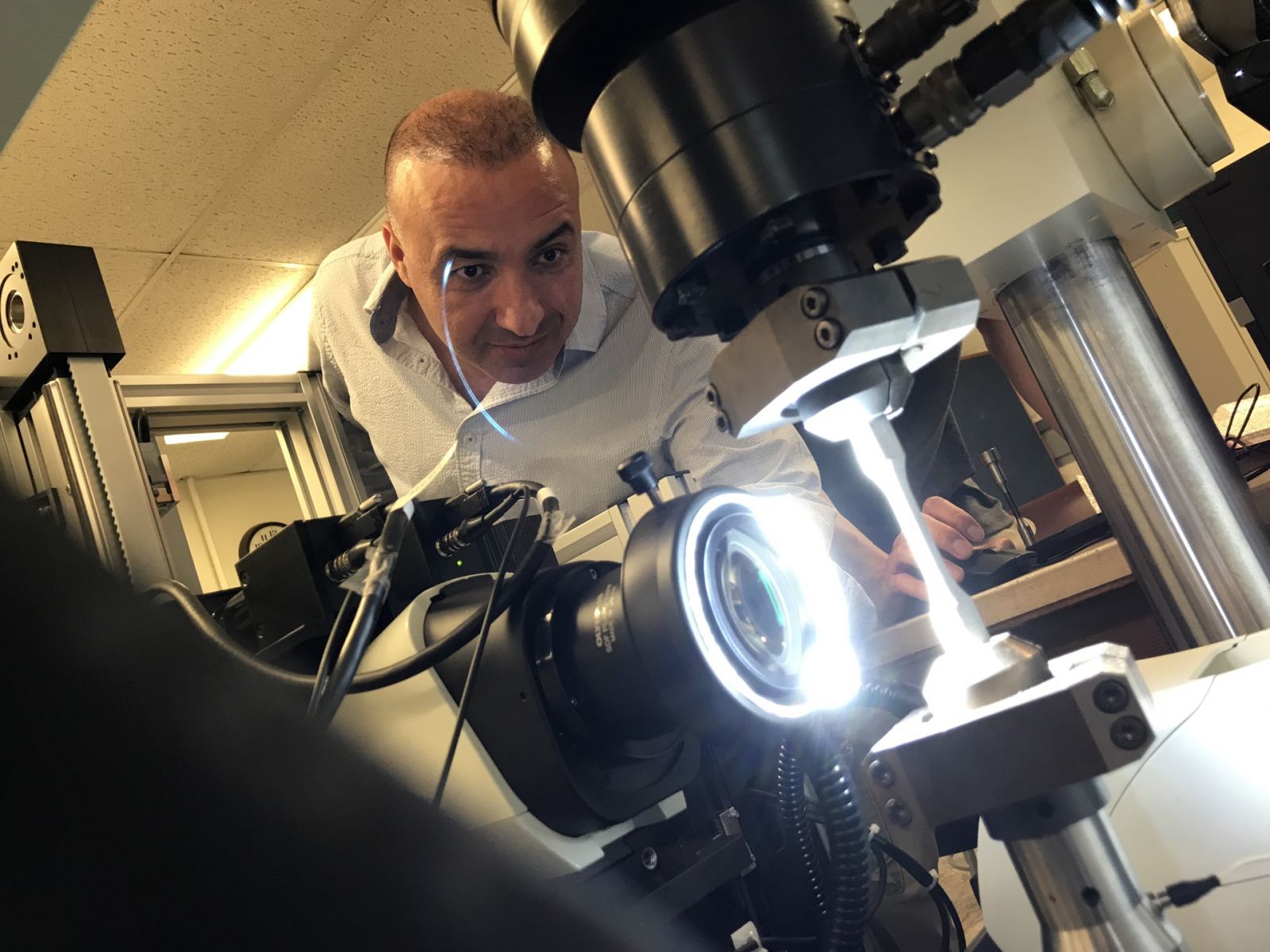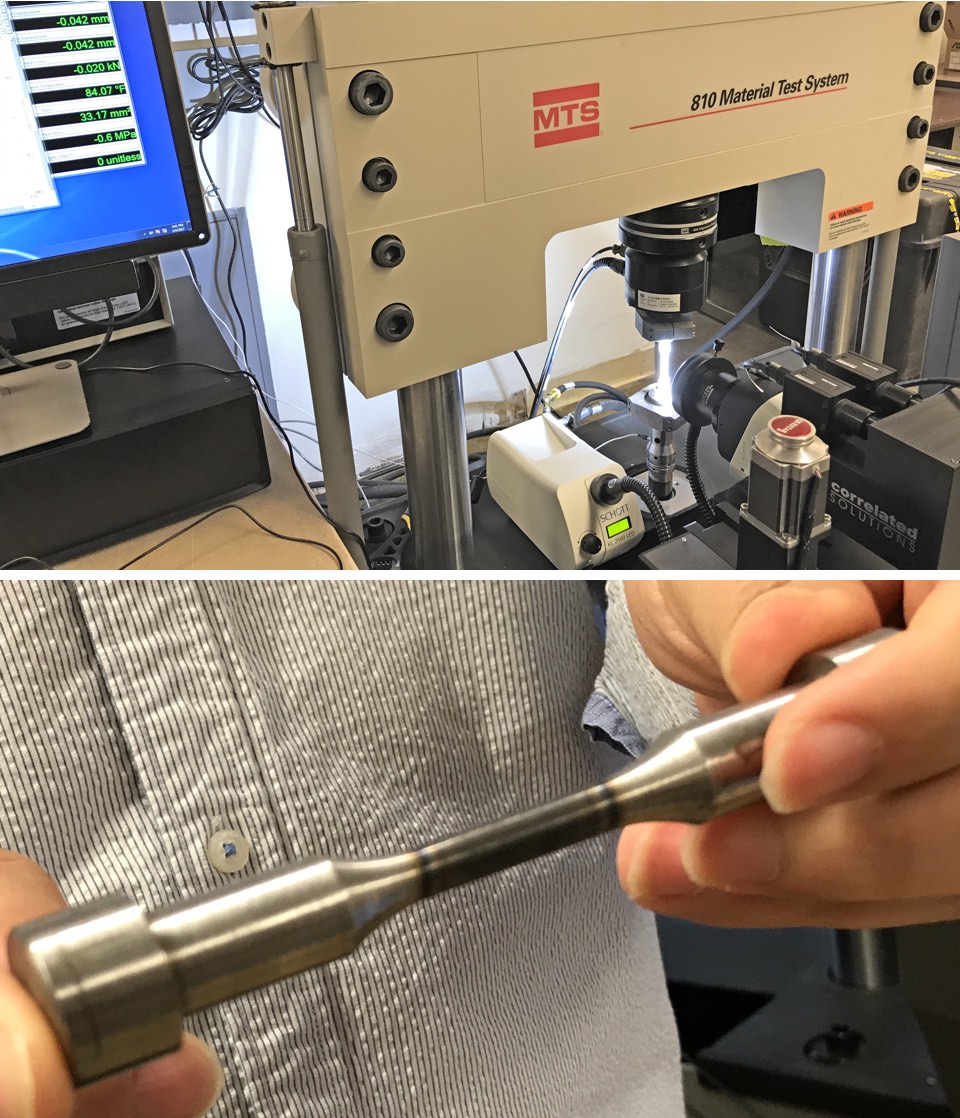
A new hydraulic machine with an integrated 3-D Microscopic Digital Image Correlation (3D-DIC) system is facilitating faster and more accurately measured experiments for research in the unification of computational models with various scale lengths to predict the growth of fatigue cracks in metals.
“We do not yet have a complete understanding of the physics behind crack damage mechanics because current models are based mainly on curve-fitting empirical models,” explained Ayhan Ince, assistant professor of engineering technology. Through fatigue testing of various notched metal specimens, he is leading the research to predict the behavior of microstructurally and physically short cracks in high cycle fatigue applications.
“This will lay the foundation for developing damage models which utilize physics-based approaches to micro and macro fracture mechanics,” Ince said. “We are examining the propagation of short cracks at various scale lengths, looking at the early stages of how cracks form and the growth of short cracks. We will then look at the propagation of mechanically long cracks.”
 Ince’s high cycle fatigue testing has been enhanced by a new high-frequency MTS 810 Fatigue Test System, a servo-hydraulic machine with an integrated 3D-DIC system. It was funded by a Defense University Research Instrumentation Program (DURIP) grant and installed in the Mechanics of Advanced Materials Research (MAMR) Lab in April.
Ince’s high cycle fatigue testing has been enhanced by a new high-frequency MTS 810 Fatigue Test System, a servo-hydraulic machine with an integrated 3D-DIC system. It was funded by a Defense University Research Instrumentation Program (DURIP) grant and installed in the Mechanics of Advanced Materials Research (MAMR) Lab in April.
With the new gear, Ince and his research team are performing fatigue testing of various notched specimens representing different component geometries, subjecting them to millions of load cycles, and making precise measurements of the deformation fields at and around the crack tip.
“Ten to 20 years ago, we didn’t have the experimental capabilities to accurately measure the stress and strain field ahead of the crack to tell whether it would stop, grow, accelerate, or decelerate since the fatigue damage doesn’t occur at a single material point. The damage occurs within a finite volume of the material,” Ince said.
The new machine allows the research team to initiate cracks up to ten times faster and measure them more accurately than they could previously. Each test provides valuable experimental short crack data for a new computational model which Ince hopes will make the behavior of short fatigue cracks more predictable.
“You generate data from experiments, work to improve the mathematical model, and then run more experiments to test the shortcomings of the developed model and further improve the models with new parameters,” said Ince. “Predicting a crack’s behavior at various length scales is an extremely challenging task, which is why no universally agreed-upon model has been developed yet.”
Ince said that his research team’s current mathematical model is providing good predictions for the behavior of both short and long fatigue cracks, but the model validation is based on a limited data set. “We want to generate more of our own data and go further, with smaller micro crack sizes. The test system helps us control and monitor that with high spatial resolution,” he said.
Experimental factors include the geometry of notched specimens, crack size, load amplitude, and displacement/strain field as well as the material composition and microstructure. “The notch area becomes the high stress location. When the geometry of the notch differs, we expect the crack behavior to be very different under same loading and boundary conditions. The crack may start earlier but grow more slowly, or it may start later and grow at an accelerated rate,” said Ince.
Applications of a future computational model for predicting short and long fatigue crack growth will vary greatly. Consider the aerospace industry, Ince suggested. Knowing the likely behavior of fatigue or damage to a metal part in an airplane, whether a commercial airliner or a fighter jet, could mean the difference between inconvenience and disaster.
The aerospace, ground transportation, nuclear, and naval industries all have need for better fatigue damage modeling, Ince said. “We want to look at different conditions and different materials to verify our results and test the robustness of our damage model before we make a bold claim.”
Ince has set a lofty goal for his research team.
“It might be too optimistic, but we hope to have a model which will work in every environment. Geometry, loading, and materials are very different,” said Ince. “It’s going to be quite challenging.”
Additional information:
